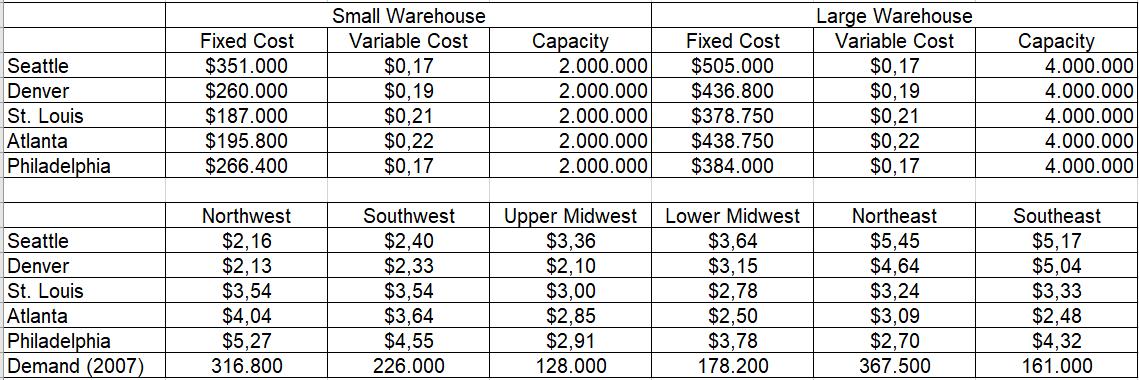Question
In December 2007, Sanjay Gupta and his management team were busy evaluating the performance at SportStuff.com over the previous year. Demand had grown by 80
In December 2007, Sanjay Gupta and his management team were busy evaluating the performance at SportStuff.com over the previous year. Demand had grown by 80 percent annually. This growth, however, was a mixed blessing. The venture capitalists supporting the company were very pleased with the growth in sales and the resulting increase in revenue. Sanjay and his team, however, could clearly see that costs would grow faster than revenues if demand continued to grow and the supply chain network was not redesigned. They decided to analyze the performance of the current network to see how it could be redesigned to best cope with the rapid growth anticipated over the next three years.
SportStuff.com
Sanjay Gupta founded SportStuff.com in 2007 with a mission of supplying parents with more affordable sports equipment for their children. Parents complained about having to discard expensive skates, skis, jackets, and shoes because children outgrew them rapidly. Sanjay’s initial plan was for the company to purchase used equipment and jackets from families and surplus equipment from manufacturers and retailers and sell these over the Internet. The idea was well received in the marketplace, demand grew rapidly, and, by the end of 2007, the company had sales of $0.8 million. By this time, a variety of new and used products were being sold, and the company received significant venture capital support. In June 2007, Sanjay leased part of a warehouse in the outskirts of St. Louis to manage the large amount of product being sold. Suppliers sent their product to the warehouse. Customer orders were packed and shipped by UPS from there. As demand grew, SportStuff.com leased more space within the warehouse. By 2007, SportStuff.com leased the entire warehouse and orders were being shipped to customers all over the United States.
Management divided the United States into six customer zones for planning purposes. Demand from each customer zone for the year 2007 is estimated to be as shown in the accompanying spreadsheet. Sanjay estimated that the next three years would see a growth rate of about 80 percent per year, after which demand would level off.
The Network Options
Sanjay and his management team could see that they needed more warehouse space to cope with the anticipated growth. One option was to enlarge the warehouse space in St. Louis itself. Other options included leasing warehouses all over the country. Leasing a warehouse involved fixed costs based on the size of the warehouse and variable costs that depended on the quantity shipped through the warehouse.
Four potential locations for warehouses were identified in Denver, Seattle, Atlanta, and Philadelphia. Leased warehouses could be either small (about 100,000 sq. ft.) or large (200,000 sq. ft.). Small warehouses could handle a flow of up to 2 million units per year, whereas large warehouses could handle a flow of up to 4 million units per year. The current warehouse in St. Louis was small. The fixed and variable costs of small and large warehouses in different locations are shown in the accompanying spreadsheet.
Sanjay estimated that the inventory holding costs at a warehouse (excluding warehouse expense) was about $(475,000×Y + 0.165×F), where F is the number of units flowing through the warehouse per year. For each facility, Y = 1 if the facility is used, 0 otherwise.
SportStuff.com charged a flat fee of $2 per shipment sent to a customer. An average customer order contained four units. SportStuff.com, in turn, contracted with UPS to handle all its outbound shipments. UPS charges were based on both the origin and the destination of the shipment and are shown in the accompanying spreadsheet. Management estimated that inbound transportation costs for shipments from suppliers were likely to remain unchanged, no matter what warehouse configuration was selected.
QUESTION: Sanjay sees value in keeping a warehouse in St. Louis, either small or large. Given this constraint, and the forecasted increase in demand in the next three years, what supply chain network configuration do you recommend for SportStuff.com for years 2008, 2009 and 2010?
BONUS (25%): Develop and write a proper linear programming model.

Large Warehouse Variable Cost Small Warehouse Variable Cost city 2.000.000 Fixed Cost Fixed Cost acity $0,17 $0,19 $0.21 Seattle $351.000 $260.000 $187.000 $505.000 $436.800 $378.750 $438.750 $384.000 $0,17 $0,19 $0,21 $0,22 $0,17 4.000.000 Denver 2.000.000 4.000.000 St. Louis 2.000.000 4.000.000 Atlanta $195.800 $266.400 $0,22 $0,17 2.000.000 4.000.000 Philadelphia 2.000.000 4.000.000 Upper Midwest $3,36 $2,10 $3,00 $2,85 $2,91 Northwest Southwest Lower Midwest Northeast Southeast $2,16 $2,13 $3,54 $4,04 $5,27 $2,40 $2,33 $3,54 $3,64 $4,55 $3,64 $3,15 $2,78 $2,50 $3,78 $5,45 $4,64 $3.24 $5,17 $5,04 $3,33 $2,48 $4,32 Seattle Denver St. Louis Atlanta Philadelphia Demand (2007) $3,09 $2,70 316.800 226.000 128.000 178.200 367.500 161.000
Step by Step Solution
3.49 Rating (152 Votes )
There are 3 Steps involved in it
Step: 1
Demand Demand 2007 Northwest 320000 Southwest 200000 Upper Midwest 160000 Lower Midwest 220000 North...
Get Instant Access to Expert-Tailored Solutions
See step-by-step solutions with expert insights and AI powered tools for academic success
Step: 2

Step: 3

Ace Your Homework with AI
Get the answers you need in no time with our AI-driven, step-by-step assistance
Get Started


